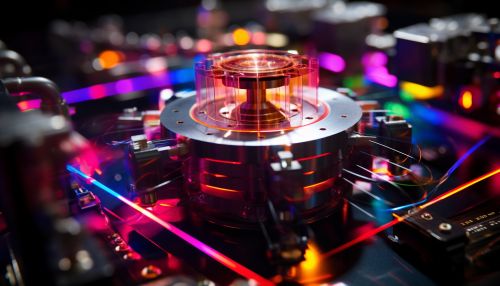Quantum Optical Memory
Introduction
Quantum optical memory refers to the storage of information in a quantum state within a medium that interacts with light. This is a key component in the development of quantum computers and quantum communication networks, as it allows for the storage and retrieval of quantum information. Quantum optical memory is a rapidly evolving field, with many different approaches being explored.
Quantum Mechanics and Optical Memory
Quantum mechanics is the branch of physics that deals with the smallest particles in the universe, such as atoms and subatomic particles like electrons and photons. In the context of quantum optical memory, the principles of quantum mechanics are used to store and retrieve information in a quantum state. This is achieved by manipulating the quantum state of a medium, such as an atom or a photon, to store information. The information can then be retrieved by measuring the state of the medium.
Principles of Quantum Optical Memory
Quantum optical memory operates on the principles of quantum mechanics, specifically the properties of superposition and entanglement.
Superposition is the principle that a quantum system can exist in multiple states at once, until it is measured. This allows for the storage of multiple bits of information in a single quantum system, significantly increasing the potential storage capacity of a quantum optical memory system.
Entanglement is the phenomenon where two or more quantum systems become linked, such that the state of one system directly influences the state of the other, regardless of the distance between them. This property is used in quantum optical memory to link the state of the memory system with the state of a photon, allowing for the storage and retrieval of information.


Types of Quantum Optical Memory
There are several types of quantum optical memory, each with its own advantages and disadvantages. These include atomic ensembles, single atoms, and solid-state systems.
Atomic ensembles are groups of atoms that are used to store quantum information. The advantage of this approach is that it allows for the storage of multiple bits of information in a single ensemble, increasing the potential storage capacity. However, this approach also has challenges, such as maintaining the coherence of the ensemble and dealing with the interaction between the atoms.
Single atoms are another approach to quantum optical memory. In this case, the quantum information is stored in the state of a single atom. This approach has the advantage of simplicity, as it avoids the complexities of dealing with an ensemble of atoms. However, it also has challenges, such as the difficulty of isolating a single atom and maintaining its quantum state.
Solid-state systems are quantum optical memory systems that use solid materials, such as crystals, to store quantum information. The advantage of this approach is that it can potentially be integrated with existing technology, making it more practical for real-world applications. However, this approach also has challenges, such as maintaining the quantum state of the solid material and dealing with the interaction between the material and the environment.
Applications of Quantum Optical Memory
Quantum optical memory has a wide range of potential applications, particularly in the fields of quantum computing and quantum communication.
In quantum computing, quantum optical memory can be used to store quantum bits, or qubits, which are the fundamental units of information in a quantum computer. This could significantly increase the storage capacity and processing power of quantum computers, making them more practical for real-world applications.
In quantum communication, quantum optical memory can be used to store and transmit quantum information over long distances. This could enable the development of quantum networks, which could provide secure communication that is immune to eavesdropping.
Future Directions
The field of quantum optical memory is still in its early stages, and there are many challenges to be overcome before it can be widely used. However, the potential benefits of quantum optical memory, such as increased storage capacity and secure communication, make it a promising area of research.
